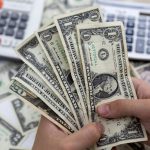
TOKYO (Reuters) -The dollar dipped to a one-month low versus the euro on Wednesday amid lower Treasury yields as traders braced for a key U.S. inflation report later in the day that could dictate the path of Federal Reserve policy.
However, the yen hovered close to a two-week low as a still-gaping yield gap between local bonds and U.S. peers continued to encourage selling of the Japanese currency.
The euro edged up 0.03% to $1.0823 in Asian trading hours, and earlier rose to $1.0828 for the first time since April 10.
The U.S. dollar index – which measures the currency against six top rivals, but is heavily weighted towards the euro – eased 0.11% to 104.94, after dipping to a 1-1/2-week low of 104.92 earlier.
The benchmark long-term U.S. Treasury yield edged down to 4.4414%, extending a 3-1/2-basis point (bp) retreat overnight.
Wednesday’s report on core consumer prices is expected to show CPI rose 0.3% month-on-month in April, down from a 0.4% growth the previous month, according to a Reuters poll.
“The market is going to sink or swim together,” Deutsche Bank strategist Alan Ruskin wrote in a note, pointing out the “extremely rare” concentration of analysts’ forecasts at 0.3%.
He noted that rate path expectations are “a little more sticky than usual” and would require more than a single modest upside or downside surprise to swing markets considerably.
However, in the event of “a large upside miss” of 0.5% or more, “early thoughts of the next move possibly being a hike would create a very large scale repricing of rates and a major USD surge against all currencies,” he said.
Fed Chair Jerome Powell gave a bullish assessment on Tuesday of where the U.S. economy stands, with an outlook for continued above-trend growth and confidence in falling inflation that, while eroded by recent data, remains largely intact.
Higher-than-expected consumer prices in the first quarter of the year were the driving force for a sharp repricing of the pace of Fed rate cuts, with those bets now pared back to about 45 bps of reductions this year.
Despite broad dollar weakness overnight against the majority of its peers, it continued to climb against the yen. The dollar edged back 0.12% to 156.245 yen on Wednesday, but had pushed as high as 156.80 overnight.
In contrast to U.S. counterparts, Japanese long-term yields stand at just 0.955%, even with Bank of Japan rhetoric turning more hawkish in recent days and prospects for another rate hike in June increasing.
The dollar’s surge to a 34-year peak of 160.245 yen on April 29 triggered two rounds of aggressive yen buying that traders and analysts suspect was the work of the BOJ and Japanese finance ministry.
“The BOJ will hope that tonight’s U.S. CPI release is in line with expectations to avoid the need for a difficult conversation tomorrow about when the appropriate time is to commence a third round of intervention – mindful that the past two rounds have yet to turn around the yen’s fortunes,” Tony Sycamore, an analyst at IG, wrote in a client note.
Elsewhere, the yuan bounced back from a two-week low versus the dollar as a report of a possible plan to ease the country’s housing glut boosted sentiment, outweighing U.S. President Joe Biden’s decision to impose steep tariff increases on an array of Chinese goods.
The dollar dropped 0.24% to 7.2232 yuan in offshore trading, after reaching the highest since May 1 at 7.2460 overnight.
Antipodean currencies also benefitted from the China optimism, with the Australian dollar gaining 0.32% to $0.6648 after earlier reaching $0.6651 for the first time since March 8.
The New Zealand dollar climbed 0.37% to $0.6062, and earlier touched $0.6064 for the first time since April 10.
To read the full article, Click Here

